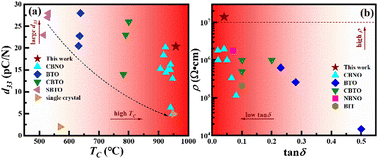Superior piezoelectricity and resistivity in CaBi2Nb2O9 high-temperature piezoelectric ceramics: synergy of structural distortion and weak texturing†
Abstract
A high ferroelectric Curie temperature TC, a large piezoelectric coefficient d33 and resistivity at high temperatures are three virtues that must be considered for piezoelectric materials with potential applications in high temperature sensors. In this paper, the effect of the B2O3 sintering aid on the microstructural and electrical properties of CaBi2Nb2O9 is comprehensively investigated. X-ray and neutron powder diffraction combined with Rietveld refinement demonstrate that a trace amount of B3+ can be incorporated into the Nb-sites in Nb–O octahedra resulting in an increase in the lattice distortion. The addition of B2O3 induces the preferential growth of grains along the c-axis, as confirmed by the corresponding (001) pole figure. The enhanced distortion degree of the Nb–O octahedra and microstructural grain orientation give rise to improvements in the ferroelectric and piezoelectric properties of CaBi2Nb2O9. The polycrystalline sample with the addition of 0.25 wt% B2O3 can realize a large d33 of 20.4 pC N−1 and an ultra-high electrical resistivity of 1.4 × 107 Ω cm (at 600 °C), while still retaining a high TC of 958 °C. These properties are comparable to those of most piezoelectric single crystals used at high temperature. This work provides a cost-effective way to improve the ferroelectric and piezoelectric properties in high temperature piezoelectric ceramics.

- This article is part of the themed collection: Journal of Materials Chemistry C HOT Papers


 Please wait while we load your content...
Please wait while we load your content...